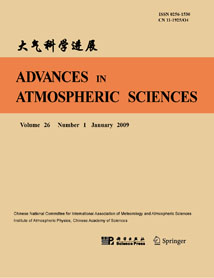| [1] |
Yu ZHAO, Anmin DUAN, Guoxiong WU,
2018: Interannual Variability of Late-spring Circulation and Diabatic Heating over the Tibetan Plateau Associated with Indian Ocean Forcing, ADVANCES IN ATMOSPHERIC SCIENCES, 35, 927-941.
doi: 10.1007/s00376-018-7217-4
|
| [2] |
Yuanchang DONG, Guoping LI, Xiaolin XIE, Long YANG, Peiwen ZHANG, Bo ZENG,
2024: Mechanism of Diabatic Heating on Precipitation and the Track of a Tibetan Plateau Vortex over the Eastern Slope of the Tibetan Plateau, ADVANCES IN ATMOSPHERIC SCIENCES, 41, 155-172.
doi: 10.1007/s00376-023-2275-7
|
| [3] |
ZHANG Xu, Hai LIN, JIANG Jing,
2012: Global Response to Tropical Diabatic Heating Variability in Boreal Winter, ADVANCES IN ATMOSPHERIC SCIENCES, 29, 369-380.
doi: 10.1007/s00376-011-1049-9
|
| [4] |
Yu Rucong, Li Wei, Zhang Xuehong, LiuYimin, Yu Yongqiang, Liu Hailong, Zhou Tianjun,
2000: Climatic Features Related to Eastern China Summer Rainfalls in the NCAR CCM3, ADVANCES IN ATMOSPHERIC SCIENCES, 17, 503-518.
doi: 10.1007/s00376-000-0014-9
|
| [5] |
ZUO Jinqing, LI Weijing, SUN Chenghu, XU Li, and REN Hong-Li,
2013: Impact of the North Atlantic sea surface temperature tripole on the East Asian summer monsoon, ADVANCES IN ATMOSPHERIC SCIENCES, 30, 1173-1186.
doi: 10.1007/s00376-012-2125-5
|
| [6] |
Lingkun RAN, Changsheng CHEN,
2016: Diagnosis of the Forcing of Inertial-gravity Waves in a Severe Convection System, ADVANCES IN ATMOSPHERIC SCIENCES, 33, 1271-1284.
doi: 10.1007/s00376-016-5292-y
|
| [7] |
Lijuan WANG, Aiguo DAI, Shuaihong GUO, Jing GE,
2017: Establishment of the South Asian High over the Indo-China Peninsula During Late Spring to Summer, ADVANCES IN ATMOSPHERIC SCIENCES, 34, 169-180.
doi: 10.1007/s00376-016-6061-7
|
| [8] |
GUO Lanli, ZHANG Yaocun, WANG Bin, LI Lijuan, ZHOU Tianjun, BAO Qing,
2008: Simulations of the East Asian Subtropical Westerly Jet by LASG/IAP AGCMs, ADVANCES IN ATMOSPHERIC SCIENCES, 25, 447-457.
doi: 10.1007/s00376-008-0447-0
|
| [9] |
Li Weiping, Theo Chidiezie Chineke, Liu Xin, Wu Guoxiong,
2001: Atmospheric Diabatic Heating and Summertime Circulation in Asia-Africa Area, ADVANCES IN ATMOSPHERIC SCIENCES, 18, 257-269.
doi: 10.1007/s00376-001-0018-0
|
| [10] |
Luo Dehai, Ji Liren,
1989: The Role of Topography and Diabatic Heating in the Formation of Dipole Blocking in the Atmosphere, ADVANCES IN ATMOSPHERIC SCIENCES, 6, 173-185.
doi: 10.1007/BF02658014
|
| [11] |
Luo Zhexian,
1987: ABRUPT CHANGE OF FLOW PATTERN IN BAROCLINIC ATMOSPHERE FORCED BY JOINT EFFECTS OF DIABATIC HEATING AND OROGRAPHY, ADVANCES IN ATMOSPHERIC SCIENCES, 4, 137-144.
doi: 10.1007/BF02677060
|
| [12] |
Zhuojian Yuan, Donald R. Johnson,
1998: The Role of Diabatic Heating, Torques and Stabilities in Forcing the Radial-Vertical Circulation within Cyclones Part II: Case Study of Extratropical and Tropical Cyclones, ADVANCES IN ATMOSPHERIC SCIENCES, 15, 447-488.
doi: 10.1007/s00376-998-0026-4
|
| [13] |
Donald R. Johnson, Zhuojian Yuan,
1999: The Role of Diabatic Heating, Torques and Stabilities in Forcing the Radial-Vertical Circulation within Cyclones Part III: Case Study of Lee-side Cyclones, ADVANCES IN ATMOSPHERIC SCIENCES, 16, 31-63.
doi: 10.1007/s00376-999-0003-6
|
| [14] |
Brian HOSKINS,
2015: Potential Vorticity and the PV Perspective, ADVANCES IN ATMOSPHERIC SCIENCES, 32, 2-9.
doi: 10.1007/s00376-014-0007-8
|
| [15] |
Zhou Libo, Zou Han, Ji Chongping, Wang Wei, Jian Yongxiao,
2001: The Scandinavia Ozone Loss and Surface Heating, ADVANCES IN ATMOSPHERIC SCIENCES, 18, 454-466.
doi: 10.1007/BF02919324
|
| [16] |
LING Jian, LI Chongyin, ZHOU Wen, JIA Xiaolong, Chidong ZHANG,
2013: Effect of Boundary Layer Latent Heating on MJO Simulations, ADVANCES IN ATMOSPHERIC SCIENCES, 30, 101-115.
doi: 10.1007/s00376-012-2031-x
|
| [17] |
Li Liming, Huang Feng, Chi Dongyan, Liu Shikuo, Wang Zhanggui,
2002: Thermal Effects of the Tibetan Plateau on Rossby Waves from the Diabatic Quasi-Geostrophic Equations of Motion, ADVANCES IN ATMOSPHERIC SCIENCES, 19, 901-913.
doi: 10.1007/s00376-002-0054-4
|
| [18] |
Wang Chunming, Wu Rongsheng, Wang Yuan,
2002: Interaction of Diabatic Frontogenesis and Moisture Processes in Cold-Frontal Rain-Band, ADVANCES IN ATMOSPHERIC SCIENCES, 19, 544-561.
doi: 10.1007/s00376-002-0085-x
|
| [19] |
Qingyi LIU, Qian LIU, Guixing CHEN,
2020: Isentropic Analysis of Regional Cold Events over Northern China, ADVANCES IN ATMOSPHERIC SCIENCES, 37, 718-734.
doi: 10.1007/s00376-020-9226-3
|
| [20] |
Yueyue YU, Yafei LI, Rongcai REN, Ming CAI, Zhaoyong GUAN, Wei HUANG,
2022: An Isentropic Mass Circulation View on the Extreme Cold Events in the 2020/21 Winter, ADVANCES IN ATMOSPHERIC SCIENCES, 39, 643-657.
doi: 10.1007/s00376-021-1289-2
|















 AAS Website
AAS Website 
 AAS WeChat
AAS WeChat 
 DownLoad:
DownLoad: